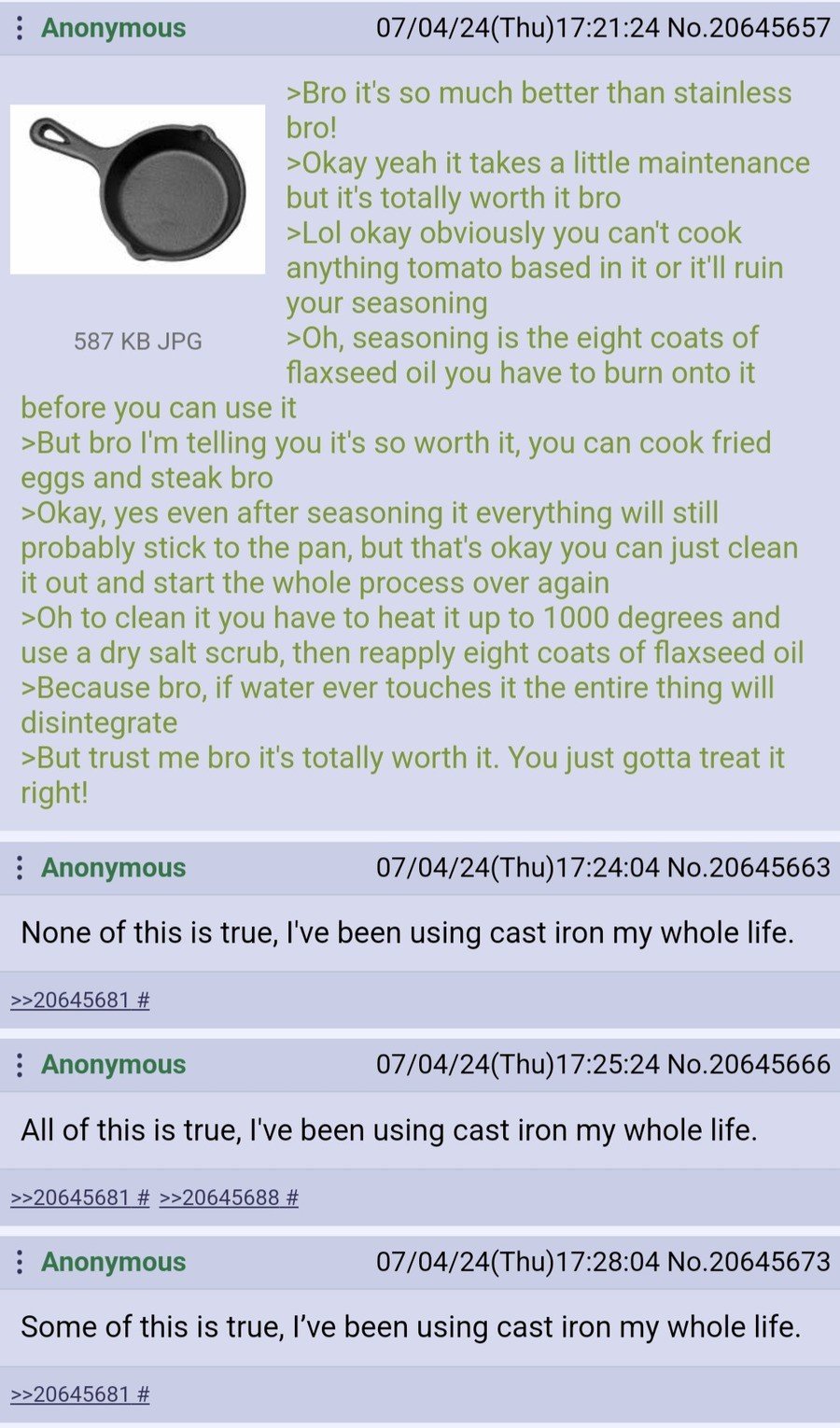this post was submitted on 02 Oct 2024
997 points (99.3% liked)
Greentext
6082 readers
1233 users here now
This is a place to share greentexts and witness the confounding life of Anon. If you're new to the Greentext community, think of it as a sort of zoo with Anon as the main attraction.
Be warned:
- Anon is often crazy.
- Anon is often depressed.
- Anon frequently shares thoughts that are immature, offensive, or incomprehensible.
If you find yourself getting angry (or god forbid, agreeing) with something Anon has said, you might be doing it wrong.
founded 2 years ago
MODERATORS
you are viewing a single comment's thread
view the rest of the comments
view the rest of the comments

I have a cast iron pan. Pros - it'll last forever if you look after it, it doesn't contain PFAS and generally it is non-stick enough to not be a nuisance. Cons - heavy AF, needs to be cleaned and dried after use & not in a dishwasher. I haven't tried to cook anything acidic in it yet but it does okay for steaks, eggs, mushrooms, sauces that I have used it for.
I still use soap and a plastic scrubber on mine and just dry it on the hob for a bit. I haven't had to reseason it yet but I imagine it will be a pain in the ass when I do. I have seen part of the seasoning flake off but it normally self heals with more cooking.
So it's okay overall but I think lack of PFAS and the fact that this thing will last a lifetime are the clinchers. Even if you have non-stick buy one of these and use it by default. I expect a stainless steel pan would be good too for same reasons.
I've heard from several sources that the iron is supposed to be good for the diet. I love my carbon steel and cast iron kitchenware. All of the studies I've seen show it as a superior option to PFAS cookware and will still outlast the latest ceramic options. I have a very non-stick carbon steel pan and griddle from avocado oil seasoning.
You didn't mention that you're oiling it after drying it. It's recommended that you lightly oil the surface upon storage.
One Source: https://www.youtube.com/watch?v=Px6jqcYFdFs
Stainless steel pans are amazing when used for the right purpose. They weigh much less than cast iron, don't require any maintenance beside cleaning them, and they are pretty much indestructible. If you burn something badly you can use metal scowering pads or any chemical you damn well like (including sodium hydroxide that will melt flesh) to get the thing clean again. They are tolerant to any cooking temperature you would ever use, ever. You can't overheat one with any appliance a normal kitchen would have. This means you can easily pop one in the oven provided it has a metal handle.
The only issue being they have no non-stick properties to speak of and relatively little thermal mass. This is good in that they don't need long to heat up, but bad in that it's not a consistent temperature and you have to know what you are doing with the power control to get the results you want. This means it's essentially useless for cooking things like steak, and difficult even to cook an omelet without using a lot of butter, ghee, or oil. Things like tomato sauces though? Perfect. The stainless steel could care less about the acidity.
So the stainless steel does care at least a little bit about the acidity?
What made you think that?
Well you said the stainless steel could care less. In order for it to be able to care less, that means it has to care at least a little bit to begin with.
Love my cast iron pan and my stainless and mostly agree. Just want to point out that stainless steel isn't really comparable to cast iron. Cast iron is cheap while good stainless pans are quite expensive, and you can't really season stainless to be nonstick. Sticking is actually a feature of stainless, because then you can use a technique called "deglazing" to make a flavorful sauce out of the stuck bits.
I have one of each and I like them both for different things.
Mostly agree. I want to add, there are ways to make your stainless steel produce a non-stick effect.
Very similar to the method used to produce a non-stick surface on carbon steel, cast iron, and other heated cooking surfaces. Essentially you apply a light coat of oil and created a polymerized surface on the pan.
One source: https://www.youtube.com/watch?v=qXEt-fhyCis
Edit: Another Source (Leidenfrost effect): https://www.youtube.com/watch?v=FUwaOnCd1h0
Look for antique CI and you'll get less weight. I love CHF (Chicago Hardware Foundry) and BSR (Birmingham something something...) pans because they're thinner casting and smooth finish. I also have some Antiques from the 19th C that get regular use. I can't stand modern pans. They are all way too heavy, and that pebbled surface is a pain in the ass to cook on and clean. It's no wonder people hate cast iron